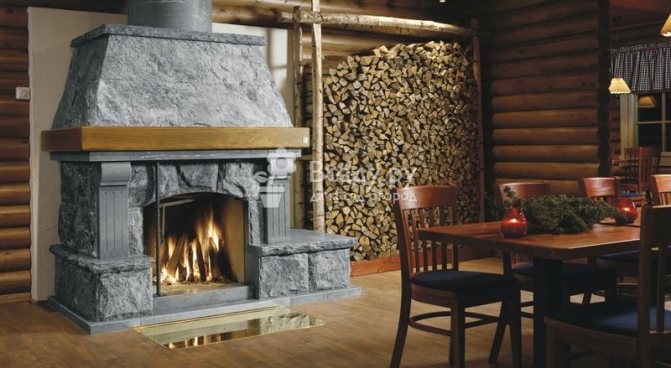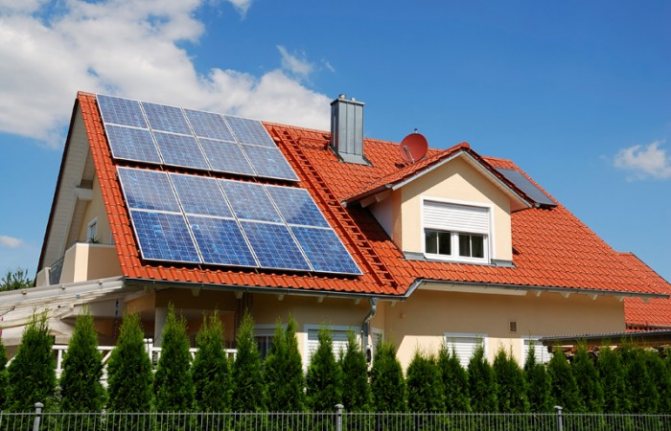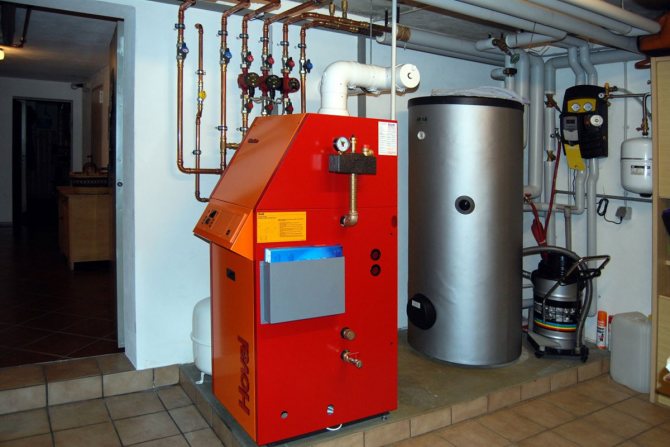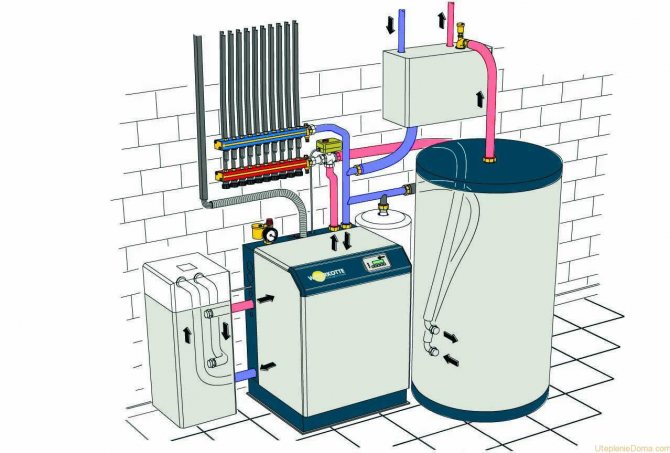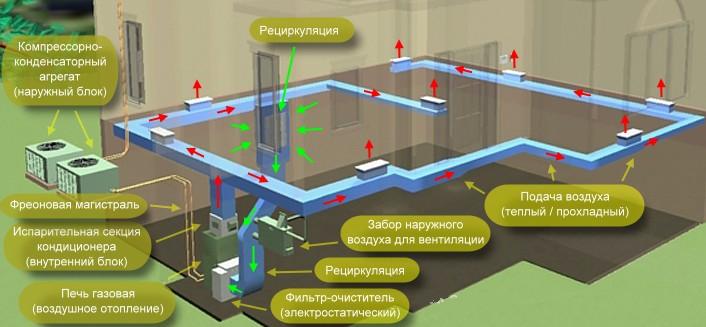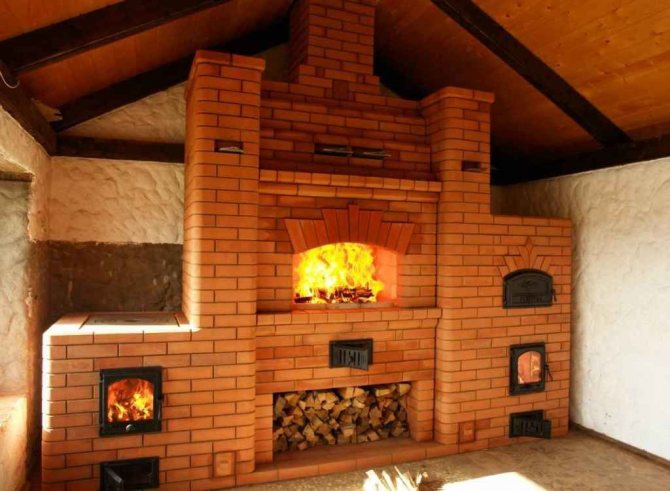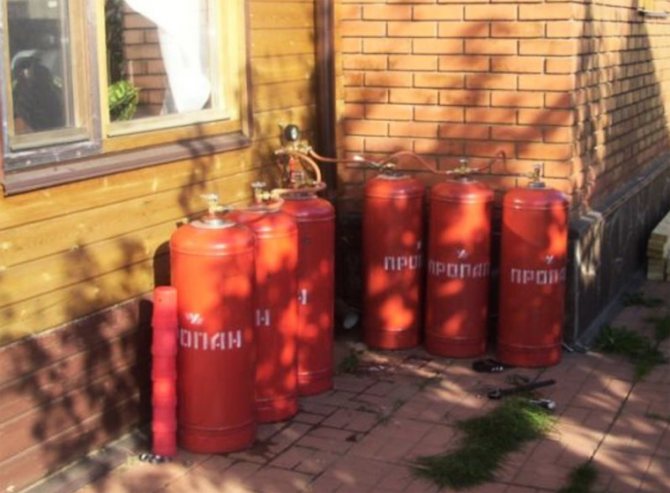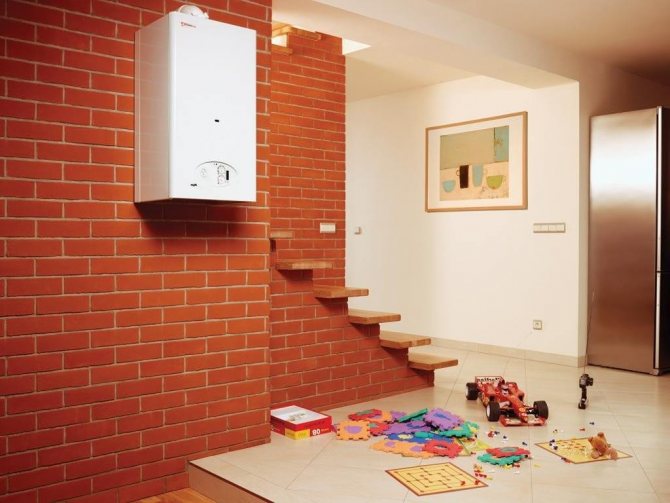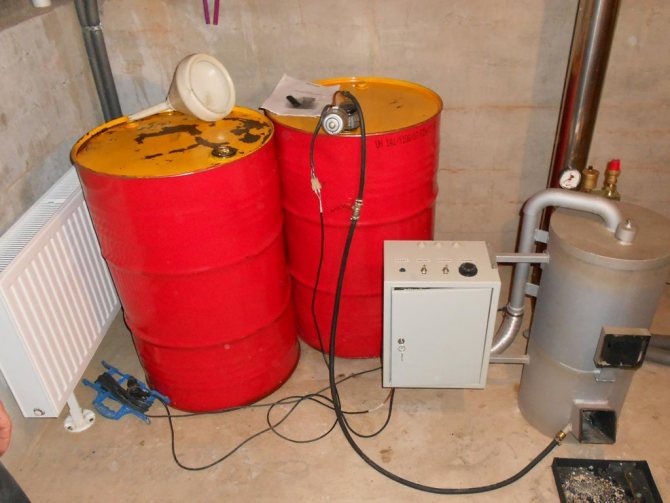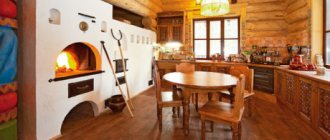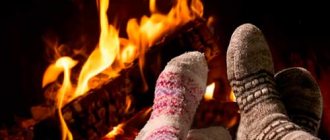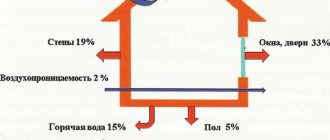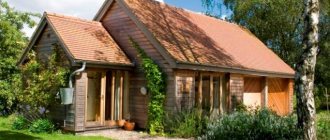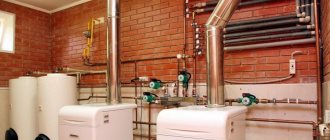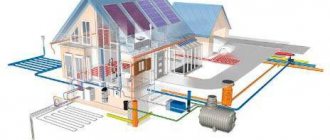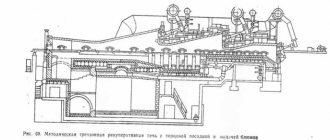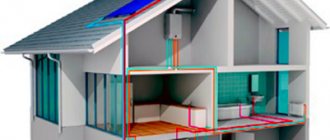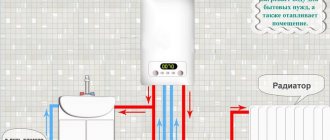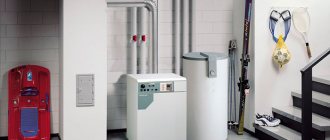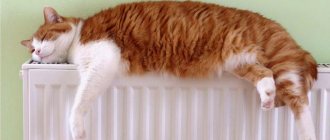Currently, such a rather unusual phenomenon as heating without gas is absolutely nothing new, besides, you can easily heat your own house without using expensive electricity. Of course, natural gas is the most affordable option for heating homes - it is economical, convenient and cheap, and natural gas is very common in Russia as well. Most people choose gas heating, as it is also easy to operate. However, there is one significant problem with gas - this is that there is a gas pipeline not in every area, especially remote from cities. That is why residents of such places have to resort to heating without gas.
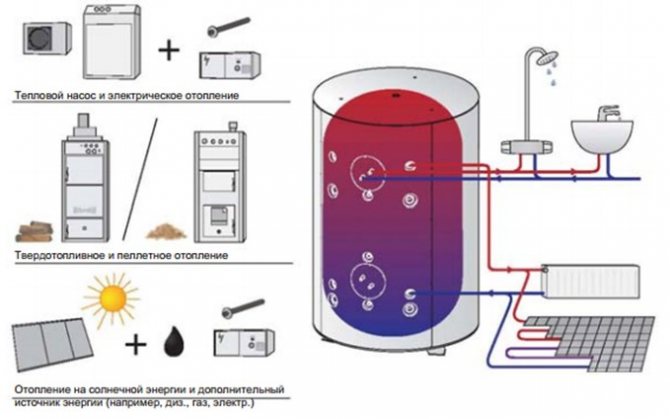
Heating methods without gas
Gas heating
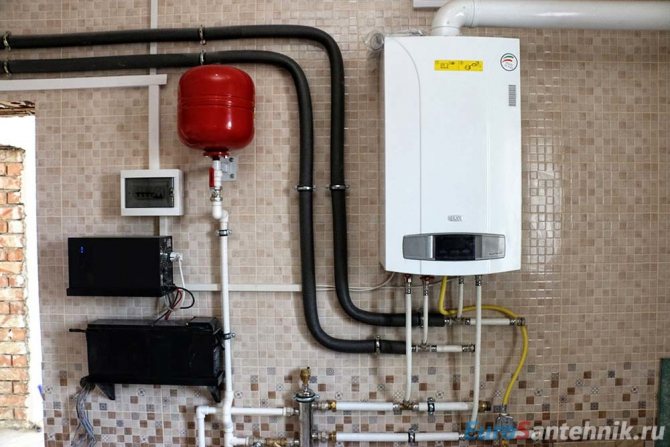

Gas heating is ideal for a country house. Round-the-clock warmth in the house at minimal cost - what else is needed. This type has a significant number of advantages:
- acceptable price;
- the ability to select the optimal boiler power depending on the heated area;
- the presence of a thermostat that allows you to control the level of heat;
- high equipment reliability;
- long service life of equipment;
- there is no need to regularly monitor the equipment and clean it.
There were also some drawbacks:
- permits are required due to the high risk;
- regular inspection of equipment by specialists is required;
- since carbon dioxide is emitted, ventilation is needed.
Of course, gas heating in a country house is possible if the main gas pipeline is connected. Unfortunately, the level of gasification in Russia is still at a negligible level. When it comes to the inexpediency of building a highway or remote areas, you can forget about gas.
There is an option of installing an autonomous gas tank, that is, a gas storage tank. In this case, all the advantages of gas heating are preserved, besides, complete independence of the owner of a country house is added.
But the gas tank requires increased accuracy and compliance with safety rules. For example, it is forbidden to fill a container with gas more than 85%. To this you need to add regular inspections and considerable costs for installing and filling the cylinder.
Thermal insulation is an important component
Reliable thermal insulation is really considered the basis of all country houses and summer cottages. With her help heating costs are reduced, emissions of dust, gases and soot are reduced, which contributes to an improvement in the environment. The optimum temperature for floors, walls and ceilings has a significant impact on the creation of a comfortable indoor environment. Good thermal insulation keeps the building in good condition and improves the quality of life.
ogon.guru
Electric heating
The first option that comes to mind when gas heating is impossible is electric heating.
With him, things are much simpler: since there is no risk of explosion, the number of permits for installation is reduced. There are 3 methods of electrical heating:
- beam (heating panels, carbon heaters);
- convective (oil radiators, convectors);
- thermal fans.
The advantages of electric heating include:
- uncomplicated installation;
- there is no need for regular inspection, inspection as needed is sufficient;
- low costs for the purchase of equipment;
- high reliability;
- there is no harmful discharge.
The disadvantages are as follows:
- on average, operation lasts no more than 8 years;
- a huge level of electricity consumption;
- instability in terms of short circuit.
If power outages are common in your area, electrical heating is best avoided. The disadvantage of large cash costs is compensated by special night rates.
Another important point regarding electric heating: so that heat does not seep through the walls, roof and windows, the country house must be well insulated. Then the approximate energy consumption is 1 kW per 10 m².
Heating by heat pump
Heat pumps are high-tech and efficient. Their use has been gaining momentum in recent years. Especially in country houses. The essence of a heat pump is to take energy from water, air and earth. Accordingly, 3 models have been developed: air / water / geothermal.
There are a huge number of pluses:
- long service life, up to 50 years;
- safety: no secretions, dirt, waste;
- economical power consumption: it releases about 3 times more energy than it absorbs;
- diesel or gasoline is suitable for engine operation (when no electricity is supplied);
- the system is automatic, so there is no need to add water, control;
- the reversible function allows you to heat a country house in cold weather, and cool it in hot weather;
- the requirements of the regulatory authorities are not strict.
Disadvantages are present in a small number:
- expensive: the main disadvantage of heat pumps;
- the compressor is working loudly, therefore, the boiler room will have to be soundproofed.
Country house owners - gardeners need to take into account the essential characteristics of heat pumps. They are absorbed by the heat from the earth (geothermal), so the soil is cooled. Heat-loving seedlings on the site may suffer.
Stove heating
A proven old-fashioned method is to heat a country house or dacha with a stove. Now this option is rather an exception. Meanwhile, stove heating is an irreplaceable thing, because:
- reliable and independent of either gas or electricity;
- inexpensive;
- environmentally friendly.
There are a little more disadvantages:
- low efficiency (however, if you place the stove in the center of the house and draw the chimney in the center, you will be able to heat the whole house);
- long heating;
- soot, soot;
- it is required to throw up fuel, watch out for coals;
- need a nook for storing firewood.
If you are not satisfied with the stove, you can replace it with a solid fuel boiler. Not only firewood is thrown into such boilers, but also coal, peat, sawdust. The advantages of solid fuel boilers are consonant with the advantages of stove heating. The disadvantages, respectively, are the same.
Experienced owners of country houses note that the best option for heating a country house often consists of a combination of several methods. A stove heating or a solid fuel boiler is perfectly combined with electric heating. During the day, the stove is used, and at night there is a transition to electric heating at a reduced rate. It will cost a little more, but one option insures the other, and various force majeure is not terrible.
Another great option is a combination boiler. The combinations are different, for example, gas + wood, electricity + wood. The advantage is that the first type of heating is easily replaced by the second. The built-in automation independently controls the fuel transitions.
Heating of old-built country houses: which is better?
Most owners of old summer cottages build ovens or ordinary brick posts... The fact is that not every settlement is equipped with gas supply.
In such summer cottages for the winter cut off the electricity supply, and for water, pipes made of metal laid on the surface of the earth are used. Speak there is no point in water heating in the cold season in this case.
The main fuel in these buildings is firewood and coal... Thanks to the ovens you need heat regularly (at least once a day), it is not always possible to quickly obtain the desired temperature. Often residents of old dachas buy electric heaters, so that upon arrival at the cottage, immediately turn them on and make up for the lack of heat.
Features of brick ovens
To understand on what principle brick ovens work, it is worth considering their central place, namely firebox for firewood. Good heating to the desired temperature will be possible only if such two conditions:
- Regular oxygen supplythat keeps the flame alive.
- Continuous withdrawal from the firebox combustion products.
The supply of fresh air to the firebox is ensured by blower door or ash pan... The combustion products gradually rise along the stone structure, entering a special opening through the combustion chamber and exiting through the chimney.
Exist different design features brick ovens, each of which has its own specific nuances. The most common models for giving are "Dutch", Russian, fireplace stoves and "Swede".
Among advantages brick ovens stand out as follows:
- compact size;
- large selection of designs;
- the possibility of equipping the summer cottage with an oven and a stove;
- fire safety.
The ovens also have several disadvantages:
- labor-intensive masonry requiring practical skills in construction;
- the high cost of the material used.
Specificity of metal furnaces
In such ovens fuel is stacked according to a peculiar principleso that there is practically no space between the elements. If we talk about firewood, then they are placed in the form of a crate. The most dense bookmark will burn for a very long time (sometimes the temperature can remain up to up to 24 hours). Firewood starts to smolder and gives off heat energy. Fresh air from the outside is fed into a special area, and not into the combustion chamber itself.
Since the main material for the assembly of such furnaces is metal, the key features of this design depend on it.
Metal poorly accumulates heat... However, its thermal conductivity relative to the heat capacity is considered to be higher in comparison with the frame fired brick.
For metal furnaces such dignity:
- excellent heat dissipation (More than 80 percent efficiency);
- compact size;
- reliability (ideal performance is characteristic of cast iron);
- unusual design.
Among disadvantages furnaces emit:
- lack of the ability to accumulate heat;
- the impossibility of creating a comfortable temperature in large summer cottages;
- low level of fire safety compared to brick structures.
What are the heaters
One of the most popular and demanded are gas heaters. They do their job from propane-butane or from a gas pipeline... In small summer cottages they usually install gas convectors and infrared heaters. Such models are simple to operate, are considered economical and have good efficiency. The only drawback is the consumption of a large amount of gas, which often hits the pocket.
The second type is best suited for giving - electrical heaters. They are divided into specific subspecies:
- Oil heaters. The most economical models for summer cottages. The main disadvantage is the long heating process to the operating temperature and the large weight of the product.
- Fan heaters... They attract users with their small size and low weight. A significant drawback is the minimum volume of the heated space.
- Electrical convectors... Such heaters occupy a small area, are safe, operate quietly and warm up the room perfectly.
- Infrared heaters.Infrared rays do not heat the air space, but nearby objects. The main disadvantage is the rapid cooling of the product.
The nuances of infrared film
The specificity of the work of infrared film is that it emits heat rays... This process is comparable to heating asphalt under the influence of the sun in summer.
Almost all infrared films have their own technical and operational features:
- mains supply is 220 V;
- power consumption at its peak is 210 W / sq. m.;
- per day electricity consumed by 20-60 W / sq. m;
- Maximum temperature IR film is 55 degrees Celsius;
- film dimensions in width - 50-100 cm.;
- up to the maximum temperature of the product heats up in a few minutes.
This type of heating is characterized by such advantages:
- quick installation;
- ease of care;
- after installation, the height of the cottage ceilings will not decrease;
- the possibility of laying over the heating layers of any floor coverings without temperature drop.
According to customer reviews, there are such heaters and negative points:
- the system can quickly fail when interacting with thin or sharp objects;
- the film increases the electrostaticity of surfaces, so dust is constantly attracted to them.
Diesel heating
Diesel heating is a safe and quite convenient option for heating a country house, used even in developed European countries.
The advantages of this type of heating include:
- non-explosive fuel, so there is no need for permits;
- a reasonable choice of the boiler will increase the efficiency up to 85-87%;
- economy and efficiency;
- easy and quick installation.
Speaking about the shortcomings, there are:
- strict requirements for the regularity of prevention;
- good quality diesel fuel is required;
- it is necessary to clean the soot from the chimney.
The most significant disadvantage: high cost. High-quality diesel fuel is expensive. During the season, about 5,000 liters of fuel are consumed, which must be purchased. In the boiler room, according to the rules, it is allowed to place a tank of 800 liters. During the season, you have to order a petrol station 4 - 6 times. If the territory permits, it is better to provide an external tank with a volume of 3-4 thousand liters.
As in the situation with electric heating, the heat from diesel fuel will be preserved provided the house is well insulated.
Long burning wood stoves and fireplace stoves
These heaters use the processes of radiation and convection to heat the air. The advantages of these heating processes include:
- Relatively low cost of devices. Simple and affordable installation and assembly of the entire heating system.
- Rapid heating of the air, which is especially valuable in the cold season. Within an hour (at -20 degrees outside), the air inside the room warms up to +18, +20 degrees.
- Independence from external energy sources (electricity, gas).
The only drawback can be considered a weak air exchange between heated and cold air in adjacent rooms without forced mixing.
A large heat transfer from wood-burning stoves is ensured when using well-dried logs.
Furnace heating requires compliance with the following safety measures:
- do not dry wet clothes on the stove;
- remove flammable objects away from the stove;
- beat the floor near the stove with iron;
- keep the chimney flap open during combustion.
Heating with liquefied gas
When a country house is used infrequently by the owners, small cylinders with liquefied gas up to 50 liters in volume will be an excellent replacement for gas heating or a massive gas tank.
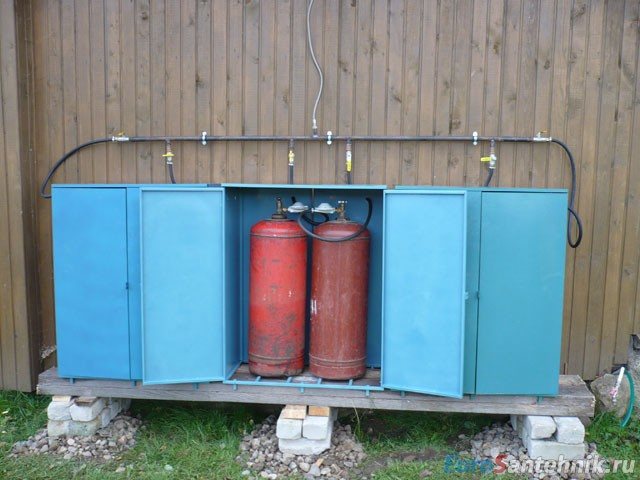

The principle of operation is standard: you need a boiler and low-power convectors. However, for security reasons, there are many installation requirements:
- the distance from the cylinder to the heat source is not less than 1 meter;
- the cylinder is connected to the convector with a steel pipe;
- it is necessary to provide free access to the gas cylinder (it is forbidden to install in the base);
- store in a standing position.
Most owners are worried about the excessive consumption of liquefied gas. When the area of the house does not exceed 50 m², you will need 2 - 3 cylinders of 50 liters for heating in winter. Of course, the lower the temperature drops in a particular area, the greater the consumption.
Which heating is more economical?
The question of saving is the first to come up in line with the owners of country cottages and summer cottages. If we take as an example a house with an area of 90 m², a heating season lasting 8-9 months, an average winter temperature of 20 degrees and an efficiency of 50%, we get the average heating costs:
- gas - 11,000 rubles;
- firewood - 23 thousand rubles. (not chipped);
- electricity - 60,000 rubles (at the daily rate).
It turns out that gas heating will least of all hit the budget, in contrast to electric non-preferential ones. Solid fuels are perfectly acceptable for use.
Solar collectors
The principle of converting solar energy into thermal energy has been known to mankind for a long time. But only relatively recently did people begin to consider the Sun as an alternative source of energy. A solar collector is a heating device that is able to accumulate the energy of the sun's rays, which is used to heat the coolant.
The principle of operation is also simple: under the plates of the structure there are tubes along which the coolant moves. When heated, it automatically flows into the water tank.
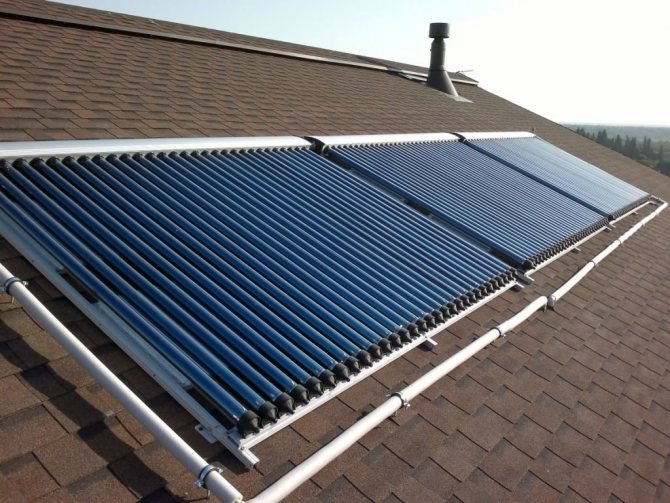

There are three types of collectors:
- Vacuum collectors. They are designed to store as much solar energy as possible with minimal waste. This is achieved due to the fact that there is a vacuum space between the outer sheets and the inner element. In general, such a unit is a system of many tubes, inside of which there is no air. Inside these tubes there are other tubes that actually heat up. Such collectors are capable of heating water up to 300 degrees Celsius.
- Flat collector. Such units are rectangular panels. They are transparent. The inner wall of this panel is covered with thermal insulation material. Under it there is a system of pipes through which the coolant moves. Such collectors heat water up to 200 degrees.
- Air manifold. Such units use air as a heat carrier. The efficiency of such collectors is low, which is the main disadvantage of this type. But they can be made independently without special technical skills and abilities. They are cheap.
Whether to fill in antifreeze
When the temperature drops to zero, the water expands by about 11%. It is easy to imagine what happens to the pipes. Antifreeze added to the water increases the viscosity of the water several times and reduces the expansion ratio. In other words, antifreeze is a salvation for the heating system.
Prudent owners who do not live in a country house in the winter should definitely take care of pouring antifreeze.
But in pursuit of the safety of the heating system, do not forget about the safety of the water supply system. If it is tee, before the cold weather, have time to drain the water. Then the water pipes will not be damaged. Antifreeze in the heating system will be useless if the country cottage has warm water floors.
The best option is to maintain the standby heating of a country house in winter at a level of 9 - 12 degrees.
Antifreezes last 5 - 8 years on average. Then acetic acid is released, which eats up the radiators. Don't forget to change in time.
Output
Calculate everything thoroughly: the area of the room, average temperatures, the availability of gas and solid fuel, the number of days per year when you are in a country house.
Whatever heating choice you choose, good building insulation will keep the heat inside the house.Consider using several heating methods at the same time: this will save you from unforeseen situations. Do not neglect regular inspections of the equipment in order to increase its life and personal safety.
We heat the house without gas and firewood
If suddenly, in the area where you have a country house, there is no opportunity not only to connect to the gas pipeline, but also to use firewood for heating, then today there are excellent alternative types of fuel for heating that can solve this seemingly serious problem.
And, first of all, consider such a method as electric boilers. But immediately we note their significant drawback - this is that electricity is a very expensive source of heat.
That is why people are trying to find alternative ways. Usually heating without gas and firewood implies the use of environmentally friendly materials and technologies that nature itself creates and gives us. And one of the options is a heat pump. Such equipment is very common, thanks to a heat pump, you can effectively heat your home using heat, which is taken from water, soil, bowels of the earth.
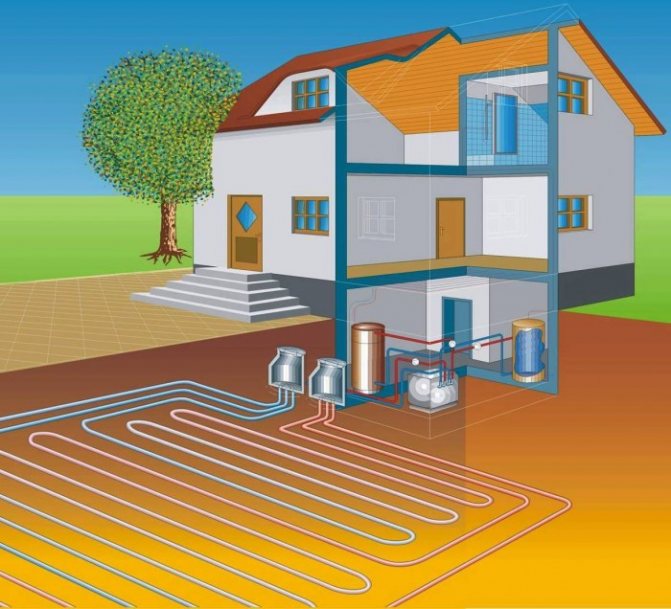

Heat pump
The only drawback of heat pumps is that the initial installation price is quite high. However, we note that it pays for itself in full for the entire life of the equipment, since there are no additional costs for maintenance.
Among the advantages of heat pumps are the following:
- Low fuel price.
- Ease of installation and maintenance of equipment.
- The system is safe for human health and the environment.
- The energy efficiency is high and even a large house can be heated at a minimum cost.

